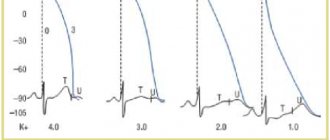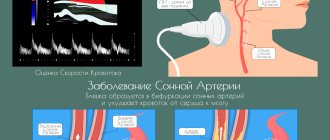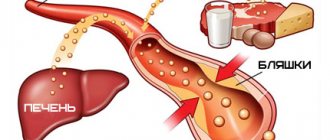Complexes with this research
Male check-up No. 1 39 studies for annual preventive examination 16,200 ₽ Composition
Miscarriage Identification of the main causes of miscarriage 35,200 ₽ Composition
Female infertility Analysis of women's reproductive health 11,720 ₽ Composition
IN OTHER COMPLEXES
- Joining IVF RUB 19,370
- For those at risk of COVID-19 RUB 3,520
- Risk of severe COVID-19 960 RUR
- Extended coagulogram RUB 3,390
- Coagulogram RUB 1,480
Possible complications of anticoagulant therapy
The main side effect of oral anticoagulant therapy is bleeding, which can manifest itself in the form of prolonged bleeding from wounds and cuts, nosebleeds, bruising on the body, changes in the color of urine (pink or red) and stool (black, bloody), etc. These complications are rare but can be very dangerous.
The risk of complications increases significantly if the INR goes beyond the individual “corridor”. Thus, your efforts should be aimed at maintaining blood clotting within the boundaries of your “corridor”.
Factors that may increase the risk of bleeding:
- Concomitant illnesses (even the common cold)
- Use of other drugs that affect blood clotting
- Inaccurate adherence to instructions for use
Symptoms that should be reported to your doctor immediately:
- Black coloring of the chair
- Pink or red urine
- Vomit that resembles “coffee grounds”
- Easily occurring bruises and swelling on the body for no apparent reason
- Nosebleeds
- Excessive bleeding from the gums (especially noticeable when brushing teeth)
- Prolonged bleeding from minor wounds and cuts
And:
- The appearance of shortness of breath, palpitations, chest pain
- Dizziness, difficulty speaking
- Visual impairment
- Numbness or impaired movement of one or more limbs
- Cold snap, pain in limbs
- Stomach ache
- A sharp increase in body weight
- Edema of the lower extremities
Detailed description of the study
Normal blood clotting is possible by maintaining a balance between the processes of blood clot formation and mechanisms that prevent excessive blood clotting.
Prothrombin is a protein that is produced in the liver and plays an important role in blood clotting. Under its action, blood clots form in case of damage to the vascular wall, and bleeding stops.
Prothrombin time (PTT) is the time in seconds it takes for a blood clot, or thrombus, to form.
Prothrombin index (PTI) is a value equal to the ratio of the PTI of the control sample to the PTI of the test sample, expressed as a percentage. The indicator is also used in conjunction with other tests included in the coagulogram to assess the risk of thrombosis or bleeding.
INR (international normalized ratio) is a calculated value characterizing the ratio of prothrombin time and prothrombin index. This indicator is used to monitor treatment with indirect anticoagulants. These drugs reduce the body's ability to form blood clots by blocking the formation of clotting factors. Patients taking anticoagulants should regularly monitor this indicator to prevent complications of anticoagulant therapy. The frequency of INR testing is determined by the attending physician.
Cardiovascular diseases, liver pathology, diabetes mellitus and some other conditions contribute to an imbalance between the blood coagulation and anticoagulation systems. During pregnancy, there is also some change in PTT, PTI and INR. It is caused by changes in hormonal regulation and related factors and usually refers to physiological conditions.
An increase in PTT may be associated with bleeding, and its reduction increases the risk of thrombosis. To prevent complications associated with thrombosis, drugs are prescribed that reduce the likelihood of vascular clot formation - anticoagulants. At the same time, these medications, if the dose is incorrectly selected, increase the risk of bleeding, which requires specialist supervision.
The results of the analysis reflect the value of all three indicators. Assessment of PTT, PTI and INR will help the doctor assess the state of the blood coagulation system and select treatment.
Prescription of medications, indications and contraindications
Medicines are manufactured in tablets, injection solutions, ointments, and gels. Anticoagulants are intended to treat and prevent the formation of blood clots. Active components affect the production of elements of the coagulation system, reduce the rate of formation of blood clots settling on the inner surface of blood vessels.
Anticoagulant medications are prescribed:
- for acute venous thrombosis;
- preventing the occurrence of thromboembolism - when replacing heart valves, supraventricular tachyarrhythmia;
- heart attacks, blockages of arterial vessels in the lungs;
- ischemic strokes;
- atherosclerotic vascular damage;
- injuries, shock, septic lesions;
- varicose veins;
- hemorrhoids with blood clots;
- formation of blood clots in the IVC.
Medications are not used:
- with lactose deficiency, impaired absorption of galactose, glucose;
- gastrointestinal ulcers, aneurysms;
- renal, liver pathologies;
- bleeding, thrombocytopenia.
The simultaneous use of anticoagulants with Aspirin, Penicillin, Dipyridamole, Cimetidine and other representatives of the NSAID group is prohibited.
During therapeutic procedures, adverse reactions may occur, which occur due to incorrectly selected doses of drugs or violation of the treatment regimen. General symptoms include attacks of nausea with vomiting, diarrhea, pain in the abdomen, allergies with nettle fever. Sometimes massive hair loss and necrosis begin.
Advantages and disadvantages of direct anticoagulant drugs
Over the past 6 years, new direct anticoagulants have appeared on the pharmaceutical market. They are an alternative to vitamin K antagonists for the treatment of thromboembolism and the prevention of thrombosis. Direct oral anticoagulants (DOAs) are a more effective and safer analogue of vitamin K antagonists.
Direct anticoagulants are the only alternative to vitamin K antagonists
The popularity of PPA among cardiologists and patients is not surprising, because the advantages include:
- rapid onset of action;
- relatively short half-life;
- the presence of specific antidote agents (may be useful in the treatment of acute ischemic strokes, as well as for eliminating post-stroke negative symptoms);
- fixed dosage;
- no direct effect of dietary supplements on the daily dose of the drug;
- no need to undergo regular laboratory blood monitoring.
The most common side effect that occurs after taking DOACs is an increased risk of bleeding. But the perceived threat of severe bleeding is quite small compared to the benefits provided by direct anticoagulants.
What you need to know
Patients prescribed oral anticoagulants should be aware that they have a large number of contraindications and side effects. When taking these medications, you need to follow a diet and take additional blood tests. It is important to calculate your daily dose of vitamin K, since anticoagulants interfere with its metabolism; Regularly monitor laboratory indicators such as INR (or INR). The patient should know the first symptoms of internal bleeding in order to seek help in time and change the drug.
Antiplatelet agents
Medicines in this group also help thin the blood and prevent the formation of blood clots, but their mechanism of action is different. Antiplatelet agents reduce blood clotting due to their ability to inhibit platelet aggregation. They are prescribed to enhance the effect of anticoagulants. In addition, they have an antispasmodic and vasodilating effect. The most popular antiplatelet agents:
- Aspirin is the most famous of this group. It is considered a very effective remedy that dilates blood vessels, thins the blood and prevents the formation of blood clots.
- Tirofiban – prevents platelet aggregation.
- Ticlopidine is indicated for cardiac ischemia, heart attacks, and for the prevention of thrombosis.
- Dipyridamole is a vasodilator.
- Eptifibatitis – blocks platelet aggregation.
Aspirin is the most famous representative of the group of antiplatelet drugs
A new generation of drugs includes the drug Brilint with the active substance ticagrelor. It is a reversible antagonist of the P2Y receptor.
Natural blood thinners
Adherents of traditional treatment methods use herbs with a blood-thinning effect to prevent thrombosis. The list of such plants is quite long:
- horse chestnut;
- willow bark;
- mulberry;
- sweet clover;
- wormwood;
- meadowsweet:
- Red clover;
- liquorice root;
- evasive peony;
- chicory and others.
Before using herbs, it is advisable to consult a doctor: not all plants can be beneficial.
Red clover is used in folk medicine as a means to improve blood flow.
Trade names of direct anticoagulants and their mechanism of action
The classification of direct-acting drugs is a little more extensive. Dabigatran etexilate (trade name Pradaxa) is a direct thrombin inhibitor. This drug was the first direct oral anticoagulant approved by the medical community. Literally within a few years, rivaroxaban inhibitors (xalerto and edoxaban) were added to the list of direct anticoagulants. Long-term clinical trials have shown the high effectiveness of the above drugs in the prevention of stroke and treatment of thrombosis. DOACs have clear advantages over warfarin, and most importantly, the drugs can be administered without regular monitoring of blood counts.
Pradaxa is the most studied direct-acting anticoagulant
The mechanism of action of DOACs differs significantly from the mechanism of vitamin K antagonists. Each direct anticoagulant contains small molecules that selectively bind to the catalytic site of thrombin. Because thrombin promotes coagulation by converting fibrinogen into fibrin filaments, dabigatran has the effect of blocking these fibrin filaments.
Additional effective mechanisms of direct anticoagulants include platelet deactivation and reduction of blood clotting activity. The half-life of this group of drugs is 7-14 hours, the time for the onset of the therapeutic effect ranges from one to four hours. Direct anticoagulants accumulate in the liver with the formation of active metabolites and are excreted from the body in the urine.
Also, two types of heparins are used as anticoagulants - unfractionated (UFH) and low molecular weight (LMWH). Low-fraction heparin has been used for the prevention and treatment of mild thrombosis for several decades. The disadvantages of UFH are that it has a variable anticoagulant effect, as well as limited bioavailability. Low molecular weight heparin is obtained from low-fraction heparin by depolymerization.
Low molecular weight heparin has a specific molecular weight distribution, which determines its anticoagulant activity and duration of action. The advantage of LMWH is that you can easily calculate the required dosage and not have to worry about severe side effects. For these reasons, it is the low molecular weight heparin that is used in most hospitals around the world.
Heparin solution is used as an anticoagulant.
Consistency and regularity are essential for effective treatment with direct anticoagulants. Because this type of drug has a short half-life, patients who miss doses intentionally or accidentally are at risk for thrombosis or inadequate coagulation. Considering that the positive effect of taking PPA quickly disappears when the drug stops entering the body, it is extremely important to follow the dosage schedule prescribed by your doctor.
Related medical procedures
Before any medical procedure, be sure to inform your doctor that you are taking anticoagulants and strictly follow his recommendations. On the eve of the procedure, monitoring the level of blood clotting is mandatory. For some dental procedures (filling, canal cleaning, removal of tartar, installation of crowns and bridges), if clotting is within the individual corridor, a change in the therapy regimen is not required. Before tooth extraction, a slight reduction in the dose of the drug taken may be required.
It must also be remembered that patients with a prosthetic heart valve require infection prevention
(bacterial endocarditis).
For this purpose, antibiotics are recommended before and after invasive intervention. This is necessary before visiting the dentist, any urological procedure, gynecological intervention, colon examination, tonsillectomy or implantation of any medical device. Back to section
Disadvantages of Vitamin K Antagonists
Warfarin is a real “old-timer” of the pharmaceutical market
Until the end of 2010, a vitamin K antagonist (warfarin) was the only oral anticoagulant approved by the World Health Organization for the prevention of thromboembolic complications in patients with non-valvular atrial fibrillation and the treatment of venous thromboembolism. For half a century, pharmacists have studied in detail the effectiveness of the drug, and also clearly identified the disadvantages and side effects.
The most common include:
- narrow therapeutic window (for poisoning it is enough to take a minimum number of tablets);
- interaction with foods rich in vitamin K (taking the tablets in combination with daily consumption of green vegetables can lead to hyperkalemia);
- delayed anticoagulant effect (this means that several weeks must pass between the start of therapy and the first results). For the prevention of venous thrombosis, this period is too long;
- the need for frequent blood monitoring and dose adjustments;
- the possibility of bruising and bleeding.









